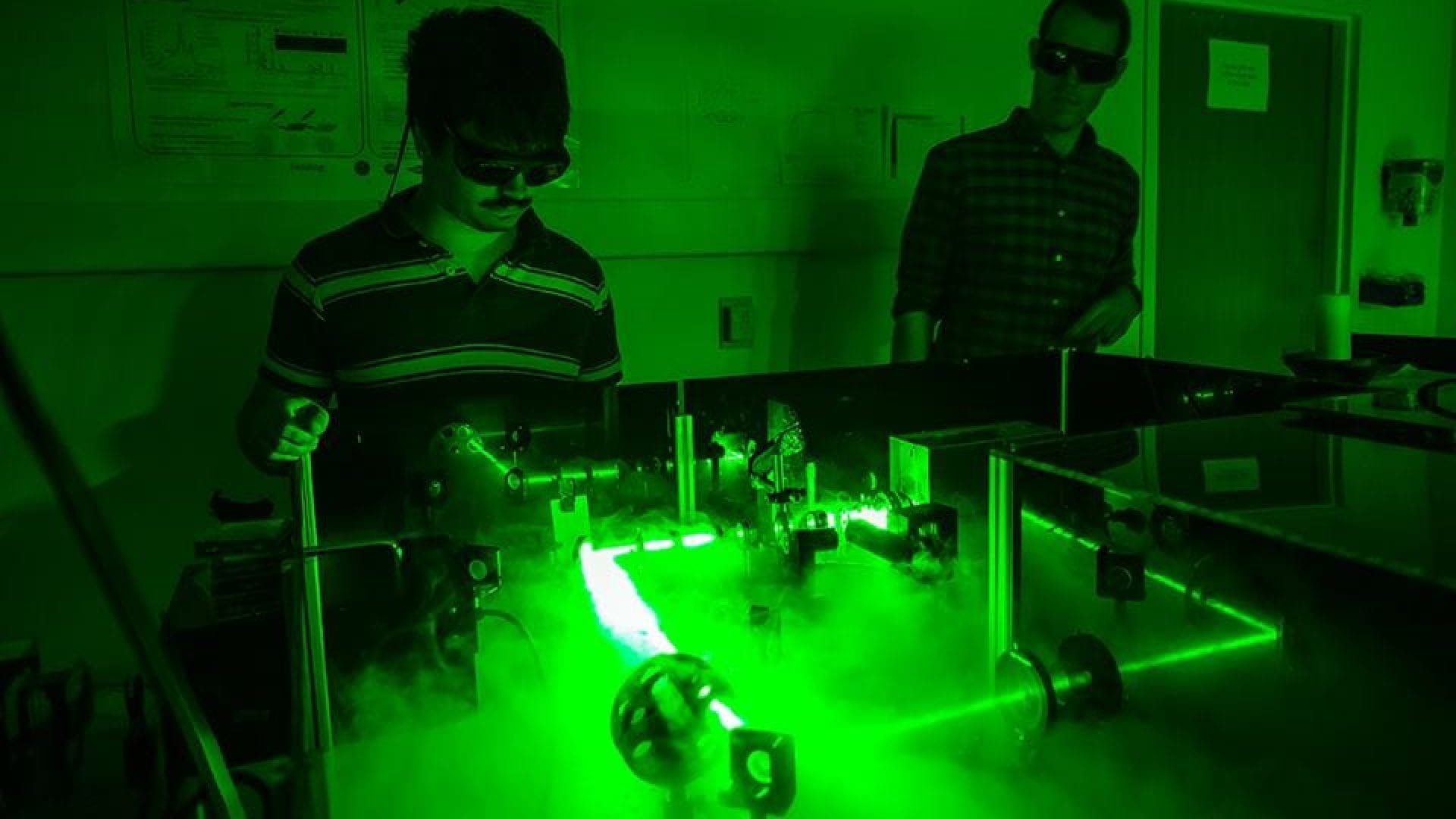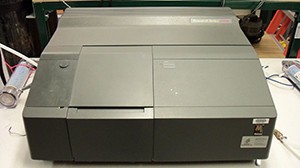Our Lab
http://https://www.youtube.com/watch?v=lgUn9ZF4vJE
Our labs consist of two main areas. The dry la b houses the laser systems and most of the instruments, while a our wet labs handle synthesis and sample preparation. Our instruments give us the ability to study photophysical processes on the femtosecond to millisecond timescale. We are currently in the process of finishing a long rebuilding/overhaul phase that included building several new spectroscopic instruments including ultrafast vis pump/vis probe, nanosecond vis pump/vis-NIR probe and nanosecond vis pump/mid-IR probe. These advances allow us to study the entire useful range of the electromagnetic spectrum for electronic materials. These techniques can be performed on thin films under constant high vacuum (~10^-7 torr) and at temperatures as low as 4 K. We also added the ability to measure photoluminescence on thin films and liquids on the nanosecond timescale over 300-2600nm range.
b houses the laser systems and most of the instruments, while a our wet labs handle synthesis and sample preparation. Our instruments give us the ability to study photophysical processes on the femtosecond to millisecond timescale. We are currently in the process of finishing a long rebuilding/overhaul phase that included building several new spectroscopic instruments including ultrafast vis pump/vis probe, nanosecond vis pump/vis-NIR probe and nanosecond vis pump/mid-IR probe. These advances allow us to study the entire useful range of the electromagnetic spectrum for electronic materials. These techniques can be performed on thin films under constant high vacuum (~10^-7 torr) and at temperatures as low as 4 K. We also added the ability to measure photoluminescence on thin films and liquids on the nanosecond timescale over 300-2600nm range.
Ultrafast Pump-Probe Spectroscopy
Nanosecond Mid-IR Transient Absorption Instrument
Our nanosecond mid-IR system was recently built (2014) for probing free and trapped charges in thin-films. The nanosecond timescale is important due to bimolecular recombination and trapping occurring on this timescale. The system has the capability of tracking polaron and free carrier species from a few nanoseconds to several milliseconds. Such an instrument cannot be commercially purchased, and it represents the only known instrument capable of performing such measurements with a dispersive geometry. The instrument features a uniquely designed IR lamp source that serves as the probe. Additionally, the system requires little to no alignment between scans and can perform measurements in transmissive or reflective sample geometries. The pump beam can be one of several lasers positioned around the instrument depending on the wavelength and pulse duration needed. Pump wavelength ranges from vis-NIR. Fast digital acquisition allows us to instantaneously collect the entire time spectrum (ns-ms) in a signal laser shot. The probe wavelength range is 500 to 4000 wavenumbers (2500-20,000 nm). The broad range allows overlap with our NIR transient system, allowing for board transient features to be followed. The entire instrument was designed by the group’s students and represents one of our technique development projects.
Nanosecond Vis-NIR Transient Absorption/Photoluminescence Instrument
The nanosecond vis-NIR system was built concurrently with the ns-MIR system (2016). The nanosecond timescale is important due bimolecular recombination and trapping occurring on this timescale and serves as a complementary technique to our mid-IR capabilities. Being able to view ground state bleaches (GSB) and excited state absorption (ESA) allows us to correlate free carrier kinetics on the mid-IR timescale to changes in the electric state of the material we are investigating. The instrument features feedback stabilized tungsten halogen lamp source as the probe. Additionally, the system requires little to no alignment between scans and can perform measurements in transmissive or reflective sample geometries. The pump beam can be one of several lasers positioned around the instrument depending on the wavelength and pulse duration needed. Pump wavelength ranges from vis-NIR. Fast digital acquisition allows us to instantaneously collect the entire time spectrum (ns-ms) in a signal laser shot. The probe wavelength range is 300 to 2600 nm, which is with our detectionrange. The broad range allows overlap with our mid-IR transient system, allowing for board transient features to be followed in time. The entire instrument was designed by the group’s students and represents one of our technique development projects.
The instrument can also be used to measure photoluminescence of solutions and thin-films which provide valuable information regarding the emissive states of solar cell materials.
Our Lasers
Our lab features a number of steady state techniques to complement our time-resolved capabilities. These include the ability to perform temperature dependent UV-vis-NIR and mid-IR (FTIR) steady state measurements. We can measure both liquid and solid samples using a wide range of techniques (e.g. ATR, powder diffraction, variable angle, etc). Being able to record steady state spectra for all our samples is important not just for characterization, but also for normalizing transient signals.
The need to perform temperature dependent studies requires sealed cryostat sample holders and appropriate sensors and controlling electronics with liquid nitrogen or helium transfer lines. Multiple cryostats allow for high throughput experiments to be performed. We have designed our instruments so that sample holders can be swapped between instruments, allowing us to perform spectroscopies across timescales so samples are never exposed to air.
Millennium Science Complex MSC
The Millennium Science Complex (MSC) serves as a user-shared facility for materials characterization and deposition. Our group, along with our collaborators, use several of the instruments (SAXS, TEM, Profilometry, etc) for further characterizing different electronic materials. We also utilize the facilities evaporation and deposition techniques for making various substrates. Incoming students are usually trained on these techniques during their first two years of research in the group. For more information about the Millennium Science Complex and its resources, check out the Millennium Science Complex’s webpage
Techniques available to students at the Millennium Science Complex:
Transmission Electron Microscopy (TEM)
Scanning Electron Micrscopy (SEM)
X-Ray Photoelectron Spectroscopy (XPS)
X-Ray Diffraction (XRD)
Focused Ion Beam (FIB)
Particle Analysis
Atomic Force Microscopy (AFM)
Profilometry
Metal Deposition
Atomic Layer Deposition (ALD)







